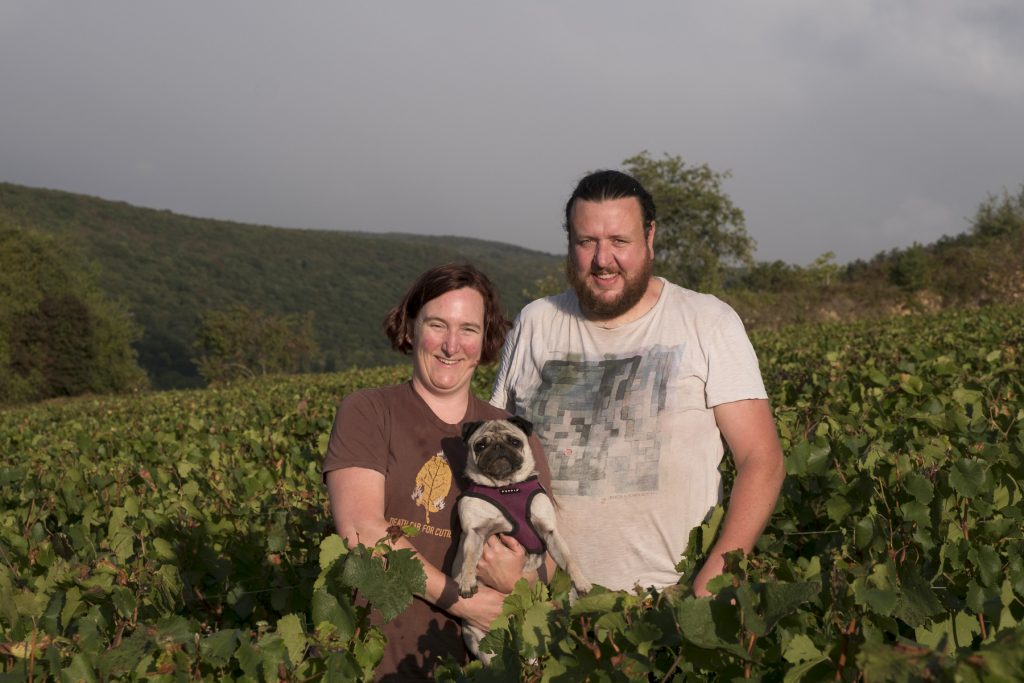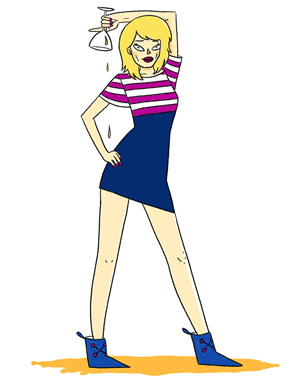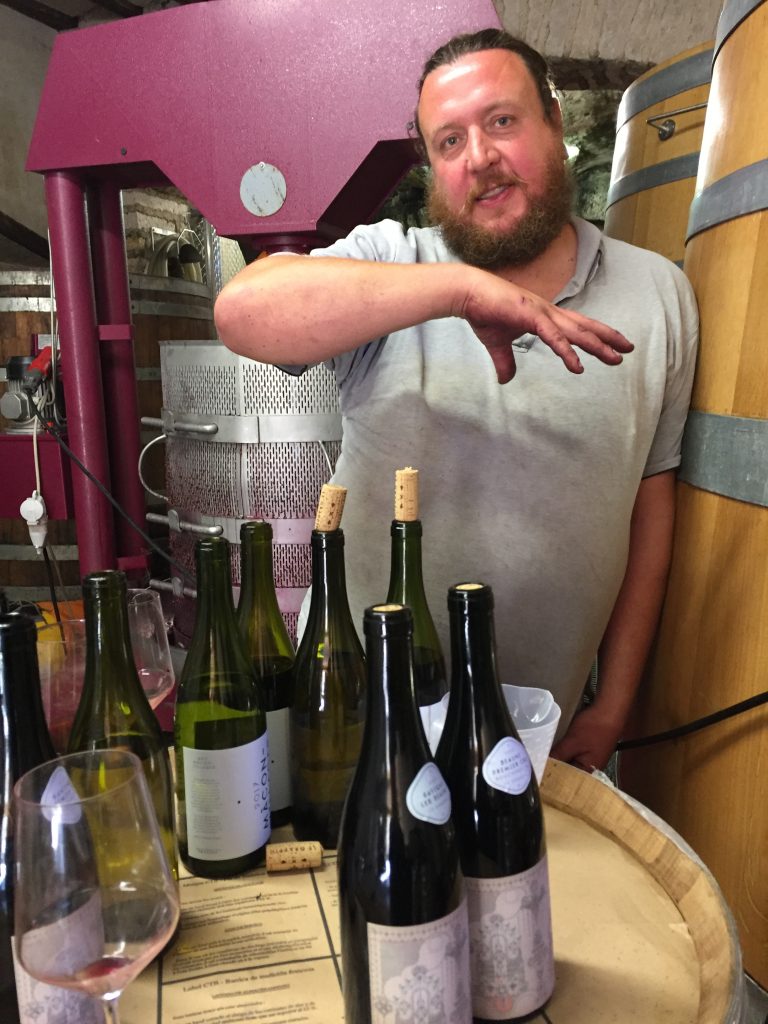
‘No touch’ winemaking is a new one for The Nose. Give me a penny for the number of times I’ve heard the expression ‘hands off winemaking’ & I’d be a rich woman… and seriously, Andrew Nielsen means it. Touch for Andrew results in tannic structure, which is not something he wants. He is chasing the aromatic complexity of Pinot.
“Tannins are not the guarantor of age-ability, but acidity” says Andrew. “You can play with whole cluster. I looked for sites with good acidity – real acidity, not acidity by picking early.”
Before setting is sights on Burgundy terroir, from which fresh acid wines flow aplenty, Andrew, a hearty, robust Australian, clearly born for making and imbibing wine, was working for The Economist. In 1996, an epiphany changed everything. “I had a bottle of Clos de la Roche Dujac, which blew my mind.” He left the office, and spent the next five years globe trotting, gleaning knowledge and getting some experience working in wineries including Felton Road in New Zealand.
Final stop was Savigny-Lès-Beaune working for the late and very kind Patrick Bize at Domaine Bize. “Patrick had twenty-one hectares and it was here I saw that in just fifty meters could make a huge difference, even in a small village, not known for great terroir differences. I wanted to make wines which show that difference; to show the character of a single vineyard.”
“Savigny-Lès Beaune, Fournaux (the village section) was the vineyard which inspired me to make Grapin. I spend the most time on this wine, as it is close to my heart. It tells the story of one place, as it is next to three villages – Aloxe, Pernard and Savigny.”
No Touch
Really? The man looks as though he’d relish some robust tannin structure in his wine, but not a bit of it. The Savigny is typical in being largely untouched by foot, pichou or for that matter pump.
“We have two to three people working at the beginning of the sorting table, selecting the awesome bunches (these are put into cases and go in last so they are at the top of the tank) and the rest stay on the table to be sorted and de-stemmed. In 2013 we had just 5% whole cluster; in 2017 it was about 30%; and in 2018, we have 70%.”
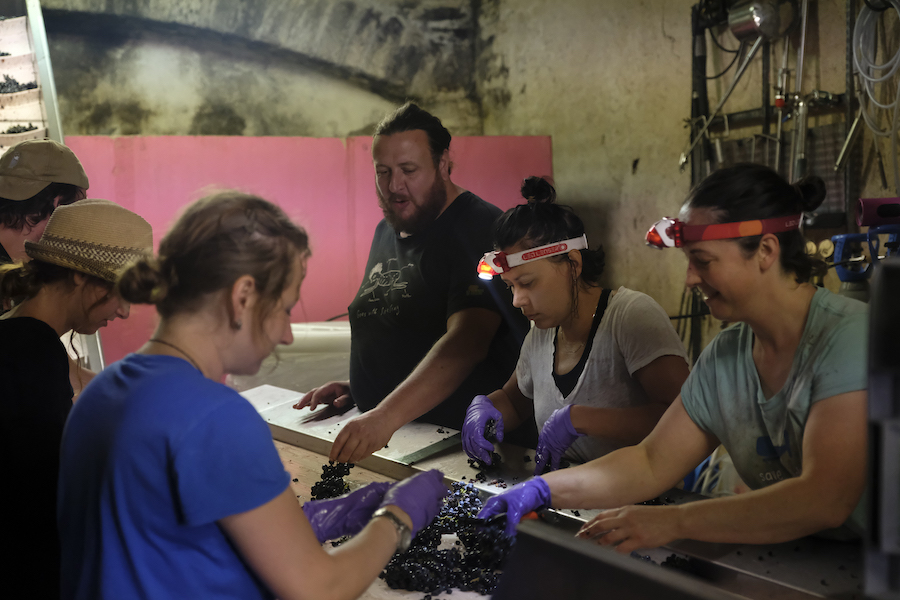
He puts the de-stemmed fruit at the bottom and fills up the tanks to the top so there is no head space and leaves them to do their stuff.
“There is no extraction and when it is dry – at a density of 995 – we crush grapes – maybe over two or three days. The tannins are quite square in this vineyard, so we are careful with them. I see the wine as just a vehicle for the aroma. I am looking for aromatic complexity, not structure.”
Andrew and his wife Emma began their winemaking adventure in a garage in Savigny… more by default than design. They have since moved to the old town in Beaune, opposite the Hotel de Ville. Emma had warned me, “We’ve really grown out of our premises, but we have such great ferments here, we can’t leave!”
Yes, well, my goodness they are bulging at the seams and there’s not much give in a medieval town. When I arrived Emma was deep in a concrete tank, one of three that shore up the back of a decidedly small space for a winery. All credit to them, they have shoehorned a surprising number of tanks and some drop dead gorgeous Stockinger (Austrian) fudres into their mini winery. And centre of all is a basket press, which was ghoulishly dripping in red wine when I pitched up at the end of harvest. Small space apart, the Nose was in aquiver with envy. A basket press indeed!
Everything is single vineyard
Andrew and Emma seem to work principally with young growers… youngsters who have recently taken over from parents. The typical parent in this scenario would have sold to negotiants and been more interested in producing quantity, than quality.
Andrew says, “I present it to them as their chance to experiment and I am often asking them to do less work – less hedging and no turning of the soil after versaison. I want the growers to buy into the idea of single vineyard, and for them to want to take their vines to the next level. My ‘red lines’ – well that would be no pesticides and no herbicides. I want them to work as close as possible to a living soil. That is a key to bright, mineral wine.”
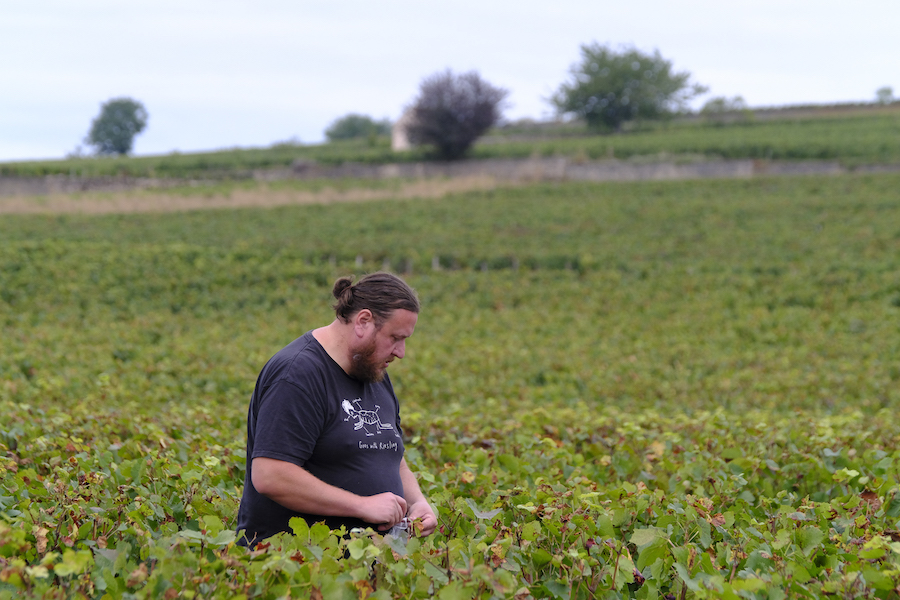
Putting aside the vineyard for a moment, in full appreciation of the fact that everything of any worth stems from here, I was rather taken by Andrew’s cut and thrust approach in the winery. No helicopter parenting of wines here.
“No sulphur. here,” says Andrew. “Indigenous yeast and lots of solids; a basket press; no deboubage – hyper-oxidise the juice, as I want to the bitterness to fall out… we’re not nasty enough with our Chardonnay. (Many aren’t). “I’m looking for texture. For Chardonnay we are very lucky here in Burgundy. We do not have to choose between minerality and ripeness – lots of places do both… being a negociant I can make my decision. So I’m looking for later ripening sites which hold their acidity. I want richness, but drive. The yeast is so amazing here, we are dry in two weeks after going into barrel, which keeps the brightness as the yeast not producing glycerol as they’re not struggling.”
“We use plenty of solids” says Andrew. I like this. The whites have body, as well as tannic bite from the whole bunch basket press.
In the lead photo you can see the basket press behind Andrew which they use for both red and white and is responsible for the slightly phenolic character – a touch of tannin – in the whites.
There is plenty of density to the palate of the whites, the richness of the terroir, the use of plenty of solids and a savoury tannic bite.“We press hard… up to 2 bar and a long press – one turning – so with one turning so almost like a vertical press and no sulphur.”
Sulphur
There is a lot of talk about sulphur in Burgundy at the moment. I’d says it’s pretty much the latest obsession. Using less of it that is. It’s an old story. Whites have suffered from pre-mature oxidation. Why? A mixture of things including over reductive wine making, too much sulphur and pneumatic presses… protective parenting if you like. An old story maybe, but pretty upsetting if you open an expensive bottle of white Burgundy, from a famous domaine, and find it’s headed over the hill, leaving you bereft of the expected expression of terroir… or indeed of anything at all.
Andrew explains his approach. “I wait ‘till the wine wakes up in the spring and is going towards oxidative… all this time it’s unprotected and it’s good for them. He doesn’t hold with nutrients either – no DAP – he might use lees from another tank, but as he says, “the wines have to work.”
There is one late addition of sulphur. Just one dose, rather than little by little. None at the press and so just one dose in March – 3-4g/l depending on the barrel.
The whites are bottled with 15-25ppm free sulphur. So only one dose of sulphur unless at bottling it is 8ppm which will need adjusting. He is bottling the reds with free sulphur of 10-15ppm.
The approach here is practical and quite earthy and robust. For example the Savigny-Les Beaune, Blanc was not at a good moment to be tasted. They had a few issues settling it. “We took all the lees from the others and put it in the wine and that settled it. Works – good as you need less fining. Lees are great for settling, great for bitterness or a struggling ferment.”
Oak: “All the new wood is on the Macon – to rise it out.”
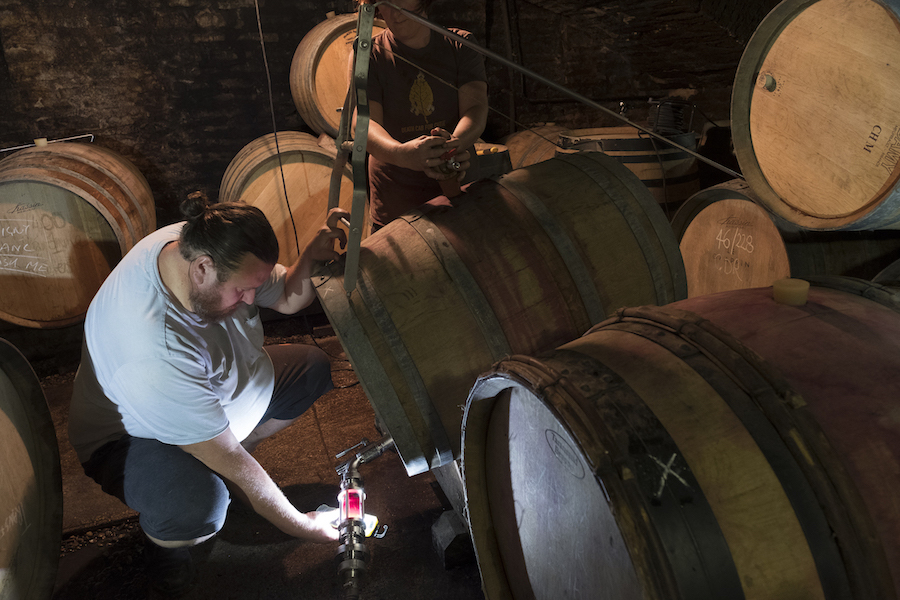
Beaujolais
While Andrew is focusing on lesser known appellations in the Côte de Beaune, or at least under-rated ones, he has also stretched south to the Beaujolais to bring Gamay into his fold.
“It’s great to be part of the Beaujolais renaissance,” he says. “Take Régnié. It’s an old Georges Duboeuf vineyard and it’s just great to bring it back to life – now there are bees and butterflies – we are surrounded by domaines doing bio-dynamics.”
The Beaujolais-Village Nature is fermented in concrete tanks. They pick some fruit to make a small ferment – taking a good look at it under the microscope to make sure it’s nice yeast at play and not something unpleasant. “We do have some not so nice stuff .. and there’s brett in this cellar,” Andrew admits. This ‘starter mix’ goes into the bottom of the tank and the remaining 95% of the harvest tops it up to rather more than full, so that when the top slides on, there should be no headspace.
“We press it off before half of the sugar is done – no piegage – so most of the fermentation is off skins, as not much done in the tank. In January we go through all the barrels and anything nice goes into bottle – so this bit has had no sulphur – and the rest can go back and has some sulphur and a later bottling. The sulphur does change the palate. Wines without sulphur are livelier.”
Cru Beaujolais:
Beaujolais, Saint-Amour: This is less well known than many cru Beaujolais – you guessed it – most of it is sold on the 14th’ February along with a terrible three course meal. Like many a Valentine’s date – this is a ‘one off for Andrew. He’s flirted with Saint Amour because he couldn’t get a date this year with Feurie. She was laid low with an attack of frost.
“I use the Chauvet method. By which Andrew means he puts into concrete tank at 10-12 degrees. “No pied de cuve… no juicing. So a slower ferment – 21 days fermentation and press at 1010 (rather then 1050 as with the Beaujolais). In the last few percentages of alcohol you get the softer tannins – most is intra-cellar fermentation and the MLF is done on skins when there is still some sugar. Chauvet was no a hipster he was a chemist. He experimented with so many things and in 1972 he developed this method…this is pure Chauvet. Any technology he did not have, we do not use. This is for the perfume. Aged in Stockinger 3000litre.”
In keeping with the winemaking the packaging might raise a few eyebrows. Wine in kegs – and why not? “The Beaujolais & Macon taste as they do in tank. It makes sense,” says Andrew. In London you can find these in kegs in Clipstone, Magpie…”
Andrew and Emma represent their own wines – selling to many restaurants as well as private clients. For examples Santenay, Gravières is list by the trendy Clove Club in Shoreditch as well as traditional fine dining places such as Le Manoir Quart Saisons and plenty of places in Paris too.
Right now for some wines.
White Wines
Macon
This is from Azé, a West facing slope, on limestone with no clay and it ripens late. It is the last parcel to come into the winery and Andrew remarks that it keeps its acidity well. Harvest in Maconnais was the 10-12th September here.
“We ferment it mainly in barrels – a little in tank last year (2017) given the lack of barrels. In January we decide what to bottle, while some continues ageing to June or July. We also make a Tête de Cuvée which is our favourite barrel or barrels – the sizes range from 300 to 600 is the biggest…”
A lovely richness on the nose. On the palate it is ripe and rounded, but there is a hint of tannin and a firm stony dry minerality on the finish. I like the touch of grip.
“We don’t fight the terroir – we accept that macon makes rich wine.”
*Saint Aubin, En l’Ebaupin
“Very cold air here – late ripening. My vines next to Pierre Yves Colin’s. En l’Ebaupin is a long and sloping vineyard. At the top there are white soils – bit like like Murgers des Dent de Chien soil and at the bottom more Chassagne-like soils and we have a cross section of the different soils. 3 to 4 rows.”
Pretty floral nose with the palate showing light citrus with some white peach coming in behind. It is quite tense and certainly straight and has a saline minerality. There are also notes of white flowers and a slightly minty hint. Very pretty. Score 15
The Saint Aubin sits on gross lees – no racking or bâtonnage. It came up (from the cellar) in mid July and settles for 4 weeks and has a very light filtration not to have lees. It has a minty note to it. “The minty hint is maybe the stem contact & the saline character is from the no sulphur ageing,” says Andrew.
Santenay, Gravières
“One of the first plantings of white in Santenay. It was all red 30 years ago and this domaine I get the fruit from recognised the potential of white. They saw the white soil and thought, ‘why are we not planting in white?’ It’s just below the windmill – so on the Chassagne side of the village. It’s their third year of conversation to organic and if they want to do this then that’s fine by me – but I just want smart work.”
Rich aroma with yellow peach. The palate is rounded and ripe. Medium full and generous, but after the fruity rich mid palate it does have minerality – a salty mineral bite.
“In the first two years I was fighting that it is a big wine. I was using no new wood and fewer solids – then I decided to go with it.” One 1 year old barrels and one 5 year old of 500l.
Santenay, Gravières 2016
This is rich, smooth and generous. More unctuous than the 2017. The minerality is glossier & encased in fruit. This has evolving very nicely – maybe the low sulphur regime makes it come around more quickly. Score 16.5
“A much richer vintage for whites” remarks Andrew.
*Beaune, Grèves
This is mid slope and a parcel of old vines next to Bouchard’s L’Enfant Jesus. “A grower was retiring and his kids were not interested so the fruit went ta Chassagne domaine, but there was little interest for him to do another white. He kept the red and I get the white. 30-50 years old plantings and it’s our biggest bruiser of a wine.”
Fulsome apricot aroma. It is generous upfront onto the palate. This is no doubt an opulent wine with good depth underscored with a straight minerality…I like straight and assertive finish. Under the depth of texture, there is tension. Score 17.95.
“This is in older barrels – 3 and a 5 year old barrels, so this creaminess is all terroir. We use the oldest wood on this.”
Red Wines
Beaujolais-Villages, Nature
“It’s on a slope… actually a better aspect then the neighbouring part of Fleurie which is rather flatter. The young grower has just got his land and is now renovating the soil. We want to encourage good growing. I pay more, but I am asking for more work here. I want higher canopies and less hedging. Concrete and whole cluster – old style, wood aged.”
This is super juicy and fruity. Very fresh, almost like a fermenting wine still. Raspberry fruits with a soft texture and a fresh finish. Very slurp-able.
Beaujolais, Saint Amour
Violets for the aroma. Blackberry fruit and flowers on the palate… very juicy with gorgeous fruit There is a spicy floral and minty note at the end. I like this. What a delich wine..
Savigny-Les-Beaune, Aux Fournau
Village and premier cru, but this is in the village section below and is next to Chandon de Briailles’s vineyards.
Deep red fruit aroma. This is full, juicy and generous. Despite the talk of ‘no touch’ there is a punch to the tannins and muscularity to the palate… but that’s Fourneaux. There is raspberry fruit here – crunchy fruit, herbal freshness at the end, which is I assume, from the whole bunch. Score 15.5
Beaune, Boucherottes
“Another underrated vineyard. Here I wanted to find a young grower taking over from his dad… It’s not got the deep clay of Pommard – more Beaune fruit.
It’s a very red soil and yet lots of big rocks limestone – more of a loam..very good drainage. Light soil. A shit ton of iron here, yet white stones too.”
“I do a bit more pigeage here – the last 3 or 4 days on skins just to release the sugar, so I don’t get a stuck ferment.”
Very intense fruity nose with lush blackberry and hedgerow fruit. This is aromatic on the palate too. Floral and fresh. 70% whole cluster. This soft and juicy wine is very inviting …it has svelte tannins, ripe and pure on the finish. Very floral. Score 17.85
To purchase
Join their mailing list. The 2017s are available en-primeur so the wine is not yet bottled. A 25% discount on retail price is offered for these early sales. You can taste the 2017 vintage in London in January.
